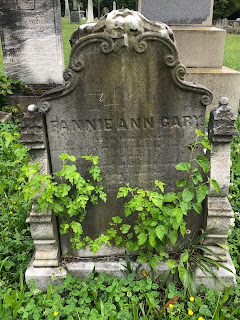I have many gardening updates to share but I've just been so busy wrapping up the semester, preparing to teach three sections of my dark tourism summer course, working on the images and editing of my forthcoming cemetery book, and focusing on June conference papers/presentations. Until I can write up posts about what's blooming, I'll share a little cemetery garden that completely took my breath away.
Yesterday, I made a quick visit to Shockoe Hill Cemetery. As I was heading out, I saw this beautiful grave. Cradle graves were quite popular during the 19th and early 20th century. They fit the iconography of rural cemeteries that emphasized resurrection with imagery of loved ones sleeping. The cradle grave also fit in the design of rural cemeteries as the interior was intended to be filled with flowers and plants, and shout out to board members of Friends of Shockoe Hill for doing a great job keeping up these flower beds. You'll notice some weeds on the outside but I assure you those are bulbs that have already bloomed in that flower bed.
 This is the grave of Fannie Ann Gary and her daughter, Fanny
Louisa Gary. I've probably walked by it a dozen times and even seen the marker
before but today, it called to me and I stopped to notice the details. The
grave is breathtaking with intricately designed flower motifs (with flowers
mostly hanging and facing downward) all around the grave. Each type of flower
had its own meaning. Lilies represent the resurrection, and roses represent
youth, love, and beauty. All the symbolism is clear when you take a moment to
understand the story.
This is the grave of Fannie Ann Gary and her daughter, Fanny
Louisa Gary. I've probably walked by it a dozen times and even seen the marker
before but today, it called to me and I stopped to notice the details. The
grave is breathtaking with intricately designed flower motifs (with flowers
mostly hanging and facing downward) all around the grave. Each type of flower
had its own meaning. Lilies represent the resurrection, and roses represent
youth, love, and beauty. All the symbolism is clear when you take a moment to
understand the story.
Fannie Ann Gary died on March 21, 1858. An epitaph for her infant daughter, Fanny Louisa Gary, who was just a few days old, is on the foot stone. The baby would pass away on April 3, 1858 having lived only 15 days. Ms. Gary had had two children prior to young Fanny but only one brother was living when the baby was born. He would die within six years of his mother and sister's death, before he was even ten.



